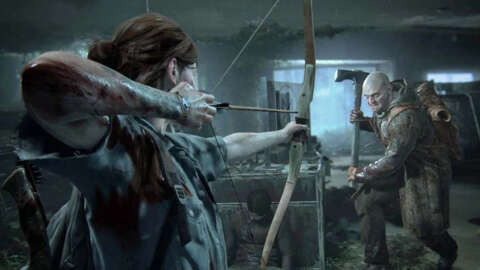When it comes to weapons in video games, each game has its own unique approach to how they work and feel. This is especially evident when comparing the bow mechanics in The Last of Us and its sequel, The Last of Us Part II. According to Derek Mattson, a senior game designer at Naughty Dog, there were various decisions that led to the changes in bow mechanics between the two games.
In an enlightening Twitter thread, Mattson discusses the two popular methods of dealing with projectiles in games. One method is used for slower-moving objects like grenades, where players can see a precise arc of movement on the screen. This allows them to accurately predict the object’s path and landing spot, with only timing and placement requiring player input. This was the original approach used for the bow mechanics in The Last of Us, with the arrow essentially functioning as a faster-moving grenade.
1. Treat the bow more like a grenade
The original TLOU does this. The 2D reticle is replaced with an in world GUI arc. The player has near perfect info on the path of the projectile. The projectile is no longer shot from the camera and the problem is circumvented all together. pic.twitter.com/kbZ4e3pMKf— Derek Mattson (@thedmatts) July 18, 2023
However, Mattson acknowledges that this approach has a lower skill ceiling and may sacrifice player satisfaction due to the lack of ambiguity in where the arrow will land. He then introduces the second approach, using Tomb Raider as an example. In this method, commonly used for firearms, the projectile originates from the point where the player’s reticle is aimed, rather than the weapon itself. While this works well for fast projectiles like bullets, it can create a disconnect when applied to bows and arrows, as the animation of the bowstring may not align perfectly with the arrow’s speed and trajectory, affecting the overall feel of the action.
The second probe comes from the bow.
We use the projected collision point from the initial probe to back calculate the arc of the 2nd probe.
This probe is what has the art. The arrow, the tracer fx, etc.
But the key to this probe is that it only collides with enemies! pic.twitter.com/yc8tXm0PE7— Derek Mattson (@thedmatts) July 18, 2023
The solution implemented in The Last of Us Part II combines elements of both approaches. As described by Mattson, the game initially fires the arrow from the camera, although this is not visible to the player. A second arrow is then calculated based on the endpoint of the invisible first arrow, creating the illusion that the motion originates from the bow while still aligning with the player’s aim. The collisions from the secondary arrow specifically target enemies, while the invisible first arrow detects all objects, preventing issues with shooting around tight angles or obstacles.
This Twitter thread offers a fascinating insight into just one aspect of the complex systems at play in video game design. It reminds us that decisions regarding mechanics and simulations require careful consideration and thought, as seen in The Last of Us Part II’s impressive glass simulation.
Denial of responsibility! TechCodex is an automatic aggregator of the all world’s media. In each content, the hyperlink to the primary source is specified. All trademarks belong to their rightful owners, and all materials to their authors. For any complaint, please reach us at – [email protected]. We will take necessary action within 24 hours.

Eugen Boglaru is an AI aficionado covering the fascinating and rapidly advancing field of Artificial Intelligence. From machine learning breakthroughs to ethical considerations, Eugen provides readers with a deep dive into the world of AI, demystifying complex concepts and exploring the transformative impact of intelligent technologies.


